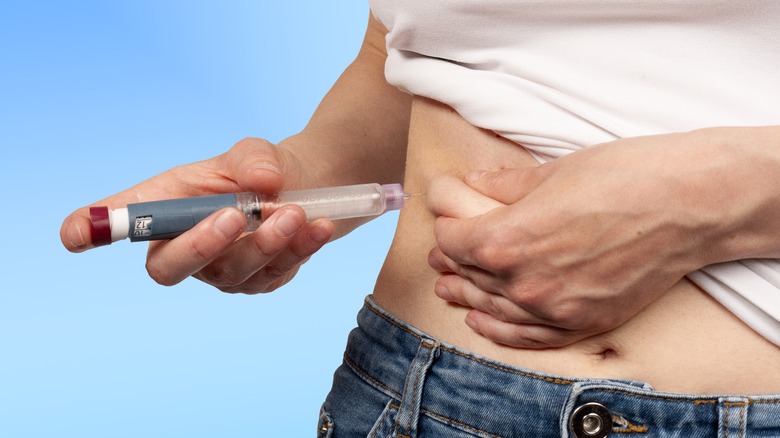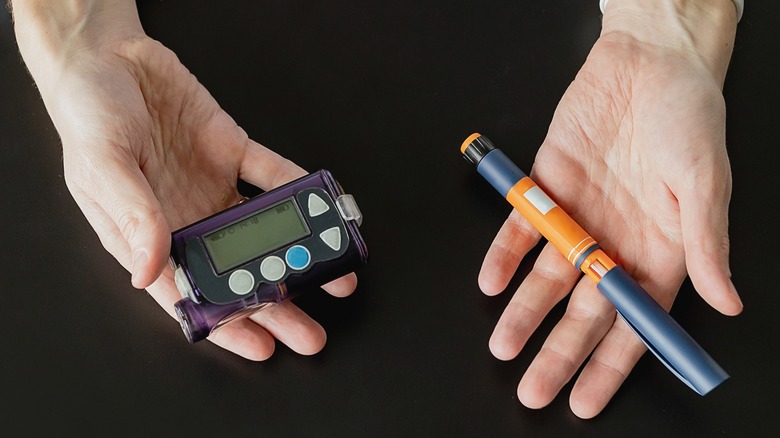What Is Type 1.5 Diabetes?
According to the Centers for Disease Control and Prevention (CDC), 37.3 million people in the U.S. have diabetes. Types 1 and 2 constitute the two common forms of diabetes. However, various diabetes-related conditions don't fit either of these two groups, hence the need for newer categories like type 1.5, per WebMD. The CDC also notes that type 1 diabetes, which develops early in life, is known to be caused by an autoimmune reaction. In contrast, type 2 diabetes is often related to lifestyle habits and weight gain. Both types of diabetes have distinct symptoms but are associated with problems with the storage and usage of glucose (via Medical News Today).
So exactly what is type 1.5 diabetes? Many researchers believe that this condition, which is often called latent autoimmune diabetes of adults (LADA), is a subtype of type 1 diabetes. Others believe LADA falls between type 1 and type 2 diabetes (via Mayo Clinic). LADA shares type 1 and 2 diabetes features, but as the name suggests, it usually remains hidden early in life only becoming apparent in people above age 30.
Causes and symptoms of type 1.5 diabetes
According to a 2012 study published in the Indian Journal of Endocrinology and Metabolism, type 1.5 shares certain characteristics with type 1 as well as type 2 diabetes. The source indicates that various factors are more common in people with LADA than those with type 2 diabetes. These include a body mass index over 25, a history of autoimmune disease in oneself or their family, age of onset of more than 50 years, and acute symptoms.
WebMD reiterates that, just like in type 1 diabetes, there is an autoimmune attack on the insulin-making cells of your pancreas. The more the pancreas loses its ability to make insulin, the harder it becomes for you to control blood sugar levels.
With type 1.5 diabetes, symptoms worsen slowly. However, Healthline notes that the initial symptoms of LADA are vague. They may include frequent thirst and urination, especially at night, as well as sudden weight loss and blurred vision. However, these symptoms can worsen if left untreated, leading to diabetic ketoacidosis, a more severe diabetic complication that can lead to death (via Mayo Clinic).
Diagnosis and treatment of type 1.5 diabetes
A 2018 study published in the journal Endocrinology and Metabolism noted three important factors that help with diagnosing LADA. They include age greater than 30 years, the presence of islet cell autoantibodies, and proof of insulin independence for at least six months after the initial diagnosis.
The similarities of LADA to type 1 and type 2 diabetes can make it difficult to diagnose it. Doctors may suspect a patient has LADA if they fail to show improvement to standard diabetic health practices. Another way to confirm LADA diagnosis is via a blood test to check for glutamic acid decarboxylase (GAD) antibodies (via Medical News Today).
As for treatment, Healthline states that insulin therapy is common for LADA patients. However, the insulin dosage varies from one person to the next. Your doctor will advise on the correct dose. Besides having insulin shots to manage blood sugar levels, various lifestyle changes may help. Cleveland Clinic notes that it might be more difficult to manage diabetes when under stress. Therefore, it's important to keep stress under control.



